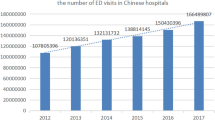Abstract
Background
Although many acute care surgery (ACS) formats exist, the model established in 2006 at our academic, level 1 trauma center includes a dedicated daytime operating room. The goal of the present study was to evaluate the effect that an ACS model with a dedicated daytime operating suite would have on outcomes and timeliness of care in patients with biliary tract disease.
Methods
A retrospective cohort study was performed on all patients with biliary tract disease admitted to the University of Alberta Hospital pre- and post-ACS. Data collected included demographic information, medical diagnoses, procedures performed, and complications. Time points included the time from admission to operation, operative time, and length of hospital stay. Pre- and post-ACS groups were compared with the Pearson Chi square test and Student’s t test (α = 0.05).
Results
There were 72 patients pre-ACS and 172 post-ACS. The two groups had similar demographics and co-morbidities. The post-ACS group had a shorter time from admission to operation (34.1 vs 24.8 h; p < 0.05). There was a decrease in the number of patients awaiting daytime operating room availability (95.8 vs 60.7 %; p < 0.05), with most surgeries being done within a 24 h period versus patients waiting upwards of 3 days pre-ACS.
Conclusions
We observed a significant decrease in preoperative time by 10 h with increased access to a readily available operating room. Having a dedicated ACS team is important, but it is equally important to have a dedicated operating room with disposable time to care for unpredictable, emergent cases to realize the full potential benefit of the ACS model.
Similar content being viewed by others
References
Hameed SM, Widder S et al (2010) General surgery 2.0: the emergence of acute care surgery in Canada. Can J Surg 53:79–82
Ball CG, Maclean AR, Dixon E et al (2012) Acute care surgery: the impact of an acute care surgery service on assessment, flow, and disposition in the emergency department. Am J Surg 203:578–583
Miller PR, Wildman EA, Chang MC et al (2012) Acute care surgery: impact on practice and economics of elective surgeons. J Am Coll Surg 214:531–535
David KA, Rozycki GS (2010) Acute care surgery in evolution. Crit Care Med 38:S405–S410
Britt RC, Weireter LJ, Britt LD (2009) Initial implementation of an acute care surgery model: implications for timeliness of care. J Am Coll Surg 209:421–424
Ball C, Hameed SM, Brenneman FD (2010) Acute care surgery: a new strategy for the general surgery patients left behind. Can J Surg 53:84–85
Ekeh AP, Monson B, Wozniak C et al (2008) Management of acute appendicitis by an acute care surgery service: is operative intervention timely? J Am Coll Surg 207:43–48
Earley AS, Pryor JP, Kim PK et al (2006) An acute care surgery model improves outcomes in patients with appendicitis. Ann Surg 244:498–504
Britt RC, Bouchard C, Weireter J et al (2010) Impact of acute care surgery on biliary disease. J Am Coll Sug 210:595–601
Lehane CW, Jootun RN, Bennett M et al (2010) Does an acute care surgical model improve the management and outcome of acute cholecystitis? ANZ J Surg 80:438–442
Lau B, DiFronzo A (2011) An acute care surgery model improves timeliness of care and reduces hospital stay for patients with acute cholecystitis. Am Surg 77:1318–1321
Casillas RA, Yegiyants S, Collins JC (2008) Early laparoscopic cholecystectomy is the preferred management of acute cholecystitis. Arch Surg 143:533–537
Shikata S, Noguchi Y, Fukui T (2005) Early versus delayed cholecystectomy for acute cholecystitis: a meta-analysis of randomized controlled trials. Surg Today 35:553–560
Wilson E, Gurusamy K, Gluud C et al (2010) Cost-utility and value-of-information analysis of early versus delayed laparoscopic cholecystectomy for acute cholecystitis. Br J Surg 97:210–219
Catani M, De Milito R, Romagnoli F et al (2008) The best timing of surgery in laparoscopic cholecystectomy for acute cholecystitis: when and how is it to be performed? Hepatogastroenterology 55:1993–1996
Hadad SM, Vaidya JS, Baker L et al (2007) Delay from symptom onset increases the conversion rate in laparoscopic cholecystectomy for acute cholecystitis. World J Surg 31:1298–1301. doi:10.1007/s00268-007-9050-2
Author information
Authors and Affiliations
Corresponding author
Rights and permissions
About this article
Cite this article
Lim, D.W., Ozegovic, D., Khadaroo, R.G. et al. Impact of an Acute Care Surgery Model with a Dedicated Daytime Operating Room on Outcomes and Timeliness of Care in Patients with Biliary Tract Disease. World J Surg 37, 2266–2272 (2013). https://doi.org/10.1007/s00268-013-2118-2
Published:
Issue Date:
DOI: https://doi.org/10.1007/s00268-013-2118-2




